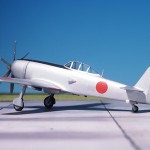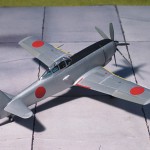TYPE: High-altitude fighter
ACCOMMODATION: Pilot in pressurized cockpit
POWER PLANT: One Nakajima Ha-44 radial engine, rated at 2,450 hp
PERFORMANCE: 442 mph at 39,370 ft (estimated)
COMMENT: In mid-1942, the Imperial Japanese Army Air Force wanted to obtain a high-altitude fighter fitted with a pressure cabin and capable of reaching a top speed of 497 mph and having a maximum range of 1,850 miles. As these performance requirements were rather stringent, the Koku Hombu decided to instruct Tachikawa to proceed with the design of the aircraft designated Ki- 94 while they placed a contract with Nakajima for another high-altitude fighter, the Ki- 87, with less stringent range requirements.
The initial aircraft was a large twin-boom monoplane with two engines mounted in tandem driving four-blade tractor and pusher propellers. But it was judged that the design was too complex and in 1943 Tachikawa submitted a new proposal to meet the same requirements as the competitive Nakajima Ki-87. The new aircraft was a single-engine high-altitude fighter of conventional design with laminar-flow wing and featuring a pressure cabin mounted in the fuselage behind the wing trailing edges. The aircraft was to be powered by a fan-cooled turbo-supercharged 2,400 hp Nakajima radial engine driving a six-blade propeller. This design was approved by the Koku Hombu, and the aircraft was designated Ki-94-II (the scrapped earlier Ki-94 design was named the Ki-94-I). An order was placed for one static test airframe, three prototypes, and eighteen pre-production aircraft. Only two prototypes were built in the event; the first was equipped with a single 2,541 hp Nakajima Ha-219 (Ha-44) engine, driving a four-blade propeller because the six-blade one was not ready. The second prototype was to be fitted with a six-blade propeller. The war’s end however stopped the construction of the second prototype and also found the first prototype still being readied for its intended maiden flight, the Ki-94-II never taking to the air (Ref.: 1, 24).











